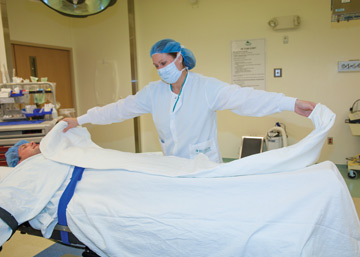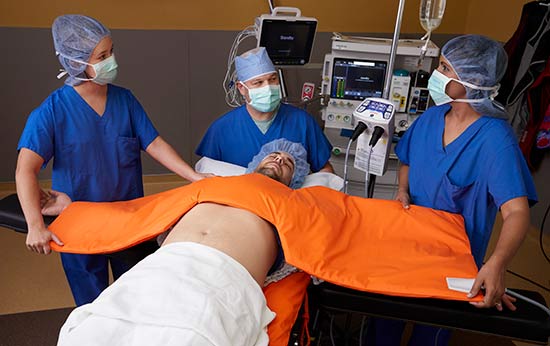The expense of active warming pales in comparison to the potential costs of inadvertent perioperative hypothermia events.
 CREDIT: Parkland Hospital
CREDIT: Parkland HospitalCALM AND COZY Justin D. (J.D.) Buchert, MSN, MEd, MS, RN, places a blanket prewarmed at 130°F on a patient in pre-op.
Preventing perioperative hypothermia not only improves patient safety and satisfaction, but can also save your facility some serious dough. Parkland Hospital in Dallas tested this theory by conducting a four-week in-house study to measure whether prewarming patients helps keep them normothermic during and after surgery.
"The first thing we did was prewarm patients for 30 minutes in cotton blankets warmed to 130°F," says Justin D. (J.D.) Buchert, MSN, MEd, MS, RN, a quality specialist for surgical and trauma services at the facility. While he admits he preferred to have used active warming measures in pre-op, the facility's budget unfortunately couldn't handle the investment. "We instead opted for the warmed blankets because our hospital already owned two refrigerator-sized warming units, and they were at our disposal," he says.
During the intra-op phase, patients were actively warmed, and administered warmed IV fluids and irrigation fluids. Heated blankets were draped on patients during transport to the PACU. Staff documented patients' temperatures in pre-op, when they entered the OR and the PACU, and 30 minutes after arrival in recovery. Of the 63 patients included in the study, 20% were hypothermic in pre-op, 32% in the OR, 41% in the PACU and 7% after 30 minutes in recovery, notes Mr. Buchert. "These percentages were all well below 70%, the national average of inadvertent perioperative hypothermia in 2018," he says.
When the study was over, Parkland Hospital identified millions of dollars in potential savings. "We analyzed the previous year's patient data (2017) and compared it to the time period we measured for our study," says Mr. Buchert. "In 2017, documentation showed a staggering 70% (15,434) of the 22,049 procedures for which we had data included a hypothermic incident. These incidents cost an average of $7,000 per case, according to a literature review."
To determine potential savings, they applied that $7,000 figure to the 15,434 cases with hypothermic incidents, and added it to the savings realized by shorter lengths of stay — they determined warming would save 2.6 days of overnight stays at $875 per day — and came up with a total savings figure of $2.35 million.
.svg?sfvrsn=be606e78_3)



.svg?sfvrsn=56b2f850_5)